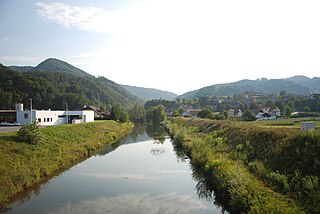| Lukovec | |
|---|---|
| Coordinates: 45°59′27.06″N15°18′25.06″E / 45.9908500°N 15.3069611°E Coordinates: 45°59′27.06″N15°18′25.06″E / 45.9908500°N 15.3069611°E | |
| Country | |
| Traditional region | Lower Carniola |
| Statistical region | Lower Sava |
| Municipality | Sevnica |
| Area | |
| • Total | 1.96 km2 (0.76 sq mi) |
| Elevation | 316.4 m (1,038.1 ft) |
| Population (2002) | |
| • Total | 187 |
| [1] | |
Lukovec (pronounced [ˈluːkɔʋəts] ) is a small settlement in the Municipality of Sevnica in east-central Slovenia. It lies above the right bank of the Sava River east of Boštanj. The area is part of the historical region of Lower Carniola. The municipality is now included in the Lower Sava Statistical Region. [2]

The Municipality of Sevnica is a municipality along the Sava and the Mirna Rivers in southeastern Slovenia. The seat of the municipality is the town of Sevnica. Today it is part of the Lower Sava Statistical Region. It is the 12th-largest municipality by area in Slovenia.

Slovenia, officially the Republic of Slovenia, is a sovereign state located in southern Central Europe at a crossroads of important European cultural and trade routes. It is bordered by Italy to the west, Austria to the north, Hungary to the northeast, Croatia to the southeast, and the Adriatic Sea to the southwest. It covers 20,273 square kilometers (7,827 sq mi) and has a population of 2.07 million. One of the successor states of the former Yugoslavia, Slovenia is a parliamentary republic and a member of the United Nations, of the European Union, and of NATO. The capital and largest city is Ljubljana.

The Sava is a river in Central and Southeastern Europe, a right tributary of the Danube. It flows through Slovenia, Croatia, along the northern border of Bosnia and Herzegovina, and through Serbia, discharging into the Danube in Belgrade. Its central part is a natural border of Bosnia-Herzegovina and Croatia. The Sava forms the northern border of the Balkan Peninsula, and the southern edge of the Pannonian Plain.
The local church is dedicated to Mary Magdalene and belongs to the Parish of Boštanj. It is originally a Romanesque building that was restyled in the Baroque in the 17th century and extended in 1888. [3]

A church building or church house, often simply called a church, is a building used for Christian religious activities, particularly for Christian worship services. The term is often used by Christians to refer to the physical buildings where they worship, but it is sometimes used to refer to buildings of other religions. In traditional Christian architecture, the church is often arranged in the shape of a Christian cross. When viewed from plan view the longest part of a cross is represented by the aisle and the junction of the cross is located at the altar area.

Saint Mary Magdalene, sometimes called simply the Magdalene, was a Jewish woman who, according to the four canonical gospels, traveled with Jesus as one of his followers and was a witness to his crucifixion, burial, and resurrection. She is mentioned by name twelve times in the canonical gospels, more than most of the apostles. Mary's epithet Magdalene most likely means that she came from the town of Magdala, a fishing town on the western shore of the Sea of Galilee.

Romanesque architecture is an architectural style of medieval Europe characterized by semi-circular arches. There is no consensus for the beginning date of the Romanesque style, with proposals ranging from the 6th to the 11th century, this later date being the most commonly held. In the 12th century it developed into the Gothic style, marked by pointed arches. Examples of Romanesque architecture can be found across the continent, making it the first pan-European architectural style since Imperial Roman architecture. The Romanesque style in England is traditionally referred to as Norman architecture.








